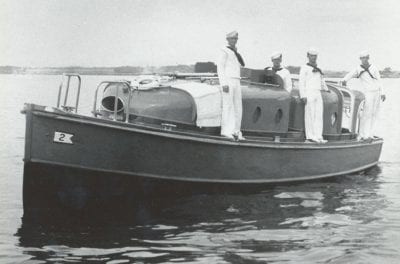George R. Keene was born April 21, 1923 at his family’s home in Highland Park, a suburb of Los Angeles, California. George is the youngest of six siblings and he attended Franklin High School before enlisting in the U.S. Navy at age 17 on March 14, 1941. George was inspired to join the military due to his older brother Charles, Jr. who had previously joined the U.S. Army and ultimately served in WWII’s European Theater.
Swarms of Japanese Fighter Planes
George had Boot Camp Training in San Diego, California, and afterwards he was immediately sent to Pearl Harbor assigned to the USS Hopkins, a Clemson Class Destroyer designed for tracking and destroying enemy submarines. For George, life was rather tranquil; after all, he was honorably serving his country and doing so in a paradise setting not far from Waikiki Beach. George and four shipmates were temporarily assigned to a Navy Gig, which they lived on. Their primary assignment was transporting senior officers throughout Pearl Harbor’s various docked ships. All was idyllic until Sunday Morning, December 7, 1941, when all hell broke loose as swarms of Japanese fighter planes swept in unannounced and began strafing and bombing everything in sight. George and his buddies were still in their bunks as thunderous explosions strangely rattled them awake. Fortunately, their Gig was tied to a dock near Ford Island, so they instantly bolted to a stand of trees in order to conceal themselves. The entire area was being bombed and strafed; George recalls seeing the USS Utah capsize after being hit by two Japanese torpedoes. Meanwhile, US Army artillerymen frantically blasted away at the Japanese fighter planes resulting in anti-aircraft flak raining down everywhere. Subsequently, George was hit in his left leg by a chunk of flak which he has on display to this day. Because it was U.S. flak, he was not awarded a Purple Heart Medal.


Guadalcanal Invasion
When the Japanese attacked Pearl Harbor, The USS Hopkins was 860 miles away at Johnston Island for war maneuvers, but immediately headed back to Hawaii; George then returned to his boiler room duties. The USS Hopkins continued patrolling the Hawaiian Sea Frontier until late summer 1942, when she joined the invasion fleet bound for Guadalcanal. As America’s first offensive of the Pacific War began, on August 7th, USS Hopkins swept the transport area supporting the Marines Corps’ landings at Guadalcanal and nearby Tulagi by firing on Japanese positions. During a heavy enemy air attack on August 9th, she (the ship) shot down two enemy planes. In the following months, USS Hopkins escorted transports, swept for mines, and carried badly needed supplies to Guadalcanal. While at Guadalcanal, Japanese artillery fired at The USS Hopkins with one shell exploding prematurely, though its concussion blasted a bolt loose in the boiler room slamming George in the head. But still, no Purple Heart for George.
Side Note
During his South Pacific tour of duty, George was temporarily assigned to a Navy cargo ship, the USS Reluctant, also known as “Mr. Robert’s Ship” from the 1955 Oscar Award winning movie. This ship, and its crew, was the inspiration for creating the movie. A number of George’s actual shipmates while on a much deserved shore leave over celebrated and were picked up by Military Police, which blemished the ship’s captain’s impeccable record.
Gitmo Training
Following Guadalcanal, the USS Hopkins patrolled numerous south Pacific islands including the Fiji Islands, New Caledonia, New Hebrides, the Solomon Islands, Russell Islands, etc. In July, 1943, George traveled to Philadelphia to attend Fuel Oil School. As a fireman, his superiors urged him to further his education. Afterwards, George was assigned to a new destroyer, the USS John A. Bole at Staten Island, New York and promptly sailed to Guantanamo Bay Naval Base, Cuba, for several months of shakedown training. Afterwards, it was back to New York City April 24, 1945, but soon George was hospitalized for 10 weeks with yellow jaundice. On August 15, 1945, Imperial Japan gave its unconditional surrender after two brutalizing atomic bombs pounded them into submission. George received his Honorable Discharge on October 4, 1945, in San Diego, and collected his military separation pay which was a whopping $42.04 plus another $1.15 for travel allowance.
The American Dream
George returned to his parent’s Highland Park home and soon pursued a job with Southern California Edison but didn’t land the job. George immediately sauntered into a local bar across the street from the Los Angeles Times, where he met a Times employee who informed him that the Times was hiring. George immediately applied and was hired to work in the facilities maintenance department. Later, he became an electrician and ultimately worked at the Times for 40 years before retiring in 1985.


George first met Gwen Smart when he was performing office electrical work in the Times typist pool. Gwen was a typist when they noticed each other, but she was dating another employee. However, George offered to escort Gwen her to visit her father, who was sadly dying. It was then that something magical materialized leading them to marry August 27, 1955, at Chapel of the Roses in Pasadena.
George and Gwen have two children, 6 grandchildren and 7 great grandchildren. In 1967, George and Gwen moved their family to Newhall into a very nice home and they’ve lived there to this day.
Pearl’s 75th Commemoration
After retirement, George busied himself with gardening in his adjacent large lot. But one of his biggest thrills came last year when visiting Pearl Harbor for their impressive 75th Commemoration of December 7th, 1941, a day that lives in infamy. Evidence of George’s proud U.S. Navy service is clearly exhibited with his numerous military memorabilia displayed in his well appointed Newhall home.












